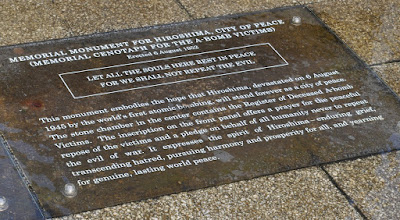Date: August 20, 2010

On our way through Japan, we stopped in Hiroshima with the main intent of educating ourselves on what happened there on August 6, 1945 - the world's first atomic bomb attack (and unfortunately not the last - Nagasaki, 3 days later). It was an extremely powerful and somber experience for us both....something we will not soon forget (even 4 months later...).
We started out by visiting what is now called the A-Bomb Dome. This building was built in 1915 and was used for a variety of purposes pre-1945; it was last called the Hiroshima Prefectural Industrial Promotion Hall. The atomic bomb exploded almost directly above it, instantly killing everyone inside. However, due to the proximity of the blast, some of the walls of the building remained standing, leaving enough of the building and iron structure at the top to be recognizable as a dome. This was one of the only structures in the area (once the bustling center of the city) not completely reduced to rubble. After the war, the citizens of Hiroshima were apprehensive to leave it standing, but today it remains as it did then (now a UNESCO World Heritage Site) and is a powerful symbol of the nation’s and humanity’s collectively shared heritage of the catastrophe. Its sacredness and sadness transcends time.
We started out by visiting what is now called the A-Bomb Dome. This building was built in 1915 and was used for a variety of purposes pre-1945; it was last called the Hiroshima Prefectural Industrial Promotion Hall. The atomic bomb exploded almost directly above it, instantly killing everyone inside. However, due to the proximity of the blast, some of the walls of the building remained standing, leaving enough of the building and iron structure at the top to be recognizable as a dome. This was one of the only structures in the area (once the bustling center of the city) not completely reduced to rubble. After the war, the citizens of Hiroshima were apprehensive to leave it standing, but today it remains as it did then (now a UNESCO World Heritage Site) and is a powerful symbol of the nation’s and humanity’s collectively shared heritage of the catastrophe. Its sacredness and sadness transcends time.
Near the A-Bomb Dome are the grounds for Peace Memorial Park, which include a number of various monuments, the Memorial Cenotaph for A-Bomb Victims, and the Hiroshima Peace Memorial Museum. It is estimated that by the end of 1945, 140,000 people died as result of the bombing (both direct and indirect) and hundreds of thousands more suffered the effects of lethal radiation exposure years and years after. The purpose of the Peace Memorial Park is to not only memorialize these victims, but also to establish the memory of nuclear horrors and to STRONGLY advocate for world peace. Within the museum, the historical details of the bombing and events leading up to / following are laid out in a very black and white fashion with no discernable political spin or blatant omissions. Basically, it happened, period. We all know who actually dropped the bomb (and I would be lying if I say I didn’t feel any national shame during my visit), but the ultimate message is, let’s (ALL of us) never let it happen again, period.
During our visit, there were a couple especially emotional moments for me. One was when listening to audio recounts of survivors describing ‘the scene’ immediately after the explosion – the screams of victims, their eyes popping out from their heads, their charred skin hanging off of their bodies. I cannot imagine. And there were pictures too (I won’t go until more detail). But above all, what stirred me the most was seeing a concrete step found in the ruins of a building now on display at the museum. On the step was a black charred stain. Someone had been sitting on that step that August morning, perhaps reading the paper, perhaps waiting for the bus, perhaps just watching the street traffic, and then boom. In an instant they were gone, leaving only that mark.

In all, I have never felt as powerful and tangible a cry for world peace as experienced that day. Hiroshima has made a call for the end of atomic weapons and there is a flame burning in the park that won’t be extinguished until all atomic weapons are destroyed and the planet is free from the threat of nuclear annihilation. It has been burning continuously since it was lit in 1964.




No comments:
Post a Comment